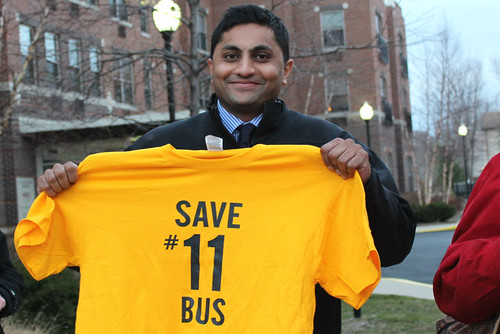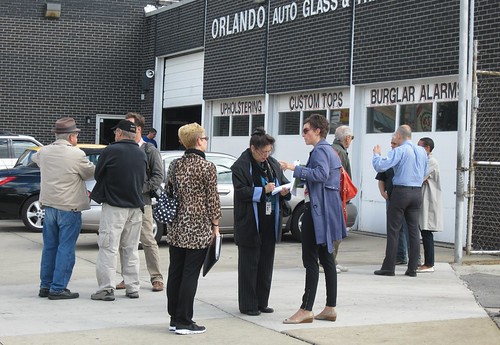Tribune transportation reporter Jon Hilkevitch was on the wrong side of history when he more-or-less predicted Divvy would flop. He eventually acknowledged the bike-share program’s success, but he’s made the same mistake with this morning’s Getting Around column, an unflattering portrayal of the CTA’s plan for fast, reliable bus rapid transit on Ashland Avenue.
Hilkevitch seems to live in an alternate reality where all Chicago aldermen and almost all business people and residents think BRT is a bad idea. He didn’t bother to talk with 47th Ward Alderman Ameya Pawar, who has shown strong support for the plan, tweeting “I can’t wait for Ashland BRT.” He didn’t contact anyone from the thirty-plus organizations and businesses listed as official supporters on the BRT Chicago website. And he apparently didn’t speak with any of the 1,700 citizens who have endorsed the plan by signing an Active Transportation Alliance petition or contacting their alderman. It also wouldn't have hurt to consult an actual transit planner who has experience with this type of project and its effects.
Instead, while the Trib piece does a decent job of outlining how BRT will work, the commentary mostly consists of aldermen, business leaders and an ex-taxi driver expressing misgivings about the plan, plus a few potshots from the reporter himself. Following the template almost all local journalists have used so far, Hilkevitch gave almost no airtime to BRT supporters, save for city officials.
“Push-back on the estimated $160 million project, which lacks a clear source of funding, is as far-reaching as its ambition,” Hilkevitch writes. Actually, the city plans to apply for grants from the Federal Transportation Administration’s Small Starts program, which provides funding for capital costs associated with new rail systems and line extensions, as well as bus corridor improvements. The Emanuel administration has an impressive track record of securing federal funds for innovative transportation projects, so a Small Starts grant is a likely scenario.
32nd Ward Alderman Scott Waguespack, generally a progressive on transportation issues, but one who seems to have an odd blind spot when it comes to innovative uses of the public way, is quoted as a BRT skeptic. "The mayor wants to see this project done at any cost, so I think it is going to move forward no matter what," he said.
Bike-friendly 12th Ward Alderman George Cardenas is another doubting Thomas. "The proponents are just like salesmen. They are set on selling you that car,” he told Hilkevitch. “But you start digging and you hit rock, you find out it is not as good as you are being told it is." The alderman argued that BRT would be more appropriate on Western Avenue because it runs through more working-class communities, even though Ashland has the highest bus ridership of all CTA routes, with more than 31,000 boardings per weekday.
If Cardenas really wants BRT on Western, the best thing he can do is to support building it on Ashland, which will prove that repurposing car lanes for bus lanes will work in Chicago, like it has in many other cities. It seems more likely that he’s looking for excuses not to support the plan. Waguespack and Cardenas should take leadership lessons from Pawar, who has the guts to speak up for a proposal he knows is good for Chicago, even if it doesn’t have unanimous support from his constituents.
Former cabbie Martin Swift, who also showed up for a Sun-Times interview session the anti-BRT group the Ashland-Western Coalition helped organize, argued the redesign will cause carmageddon. Interestingly, the article has no mention of the coalition.
"If a motorist just tries to remember the last time a busy four-lane thoroughfare was under construction and narrowed to one lane in each direction, it becomes quite simple to see why there is resistance," Swift said. He obviously doesn’t recall when Congress Parkway was reduced to two lanes in each direction for a recent rehab project, or when the north-south portion of Wacker Drive shut down for reconstruction. People simply chose different routes or opted not to drive downtown, and the traffic nightmare was averted. While an ex-taxi driver has a unique perspective on traffic, it's interesting Hilkevitch thought his opinion was more valid than that of an actual transit/transportation engineer.
Hilkevitch assets that “Cars, trucks and the non-BRT No. 9 Ashland all-stop local bus would all be crowded into the single right lane in each direction, likely resulting in most drivers being stuck behind the No. 9.” Cars getting stuck behind local buses wouldn’t be any more of a problem than it currently is on two-lane bus routes like Hasted Street and Damen Avenue. And since the Ashland locals would run infrequently, perhaps once or twice an hour, chiefly to serve people whose mobility challenges make it difficult to travel an extra block or two to BRT stations, this issue would be minimized.
The only civilian endorsement of the plan in the article comes from Burt Klein, president of Portion Pac cleaning products, 400 North Ashland. "Everybody has their work cut out for them to make this work,” he said. “But I think it's worth the time and effort to keep the jobs here in the city." When I spoke to Klein at a community meeting in January, he said he was interested in creating a better way for his employees to get to work car-free.
Hilkevitch says “civic and environmental groups” back the plan because reducing car traffic and increasing transit use is “a way to promote a world-class image for Chicago,” which makes fighting congestion sound like a rather elitist goal. He doesn’t mention that organizations ranging from the Illinois Hispanic Chamber of Commerce to the AARP to the Illinois Medical District are official supporters of the plan because converting car trips to bus trips is a commonsense way to move people more efficiently, improve traffic safety, and boost the local economy.






